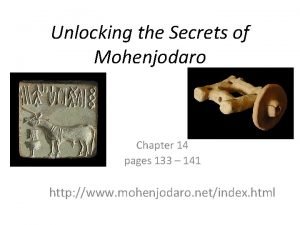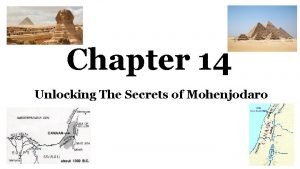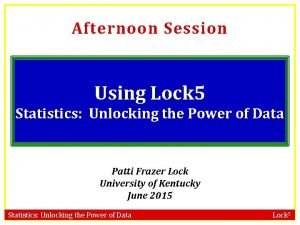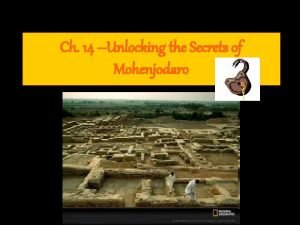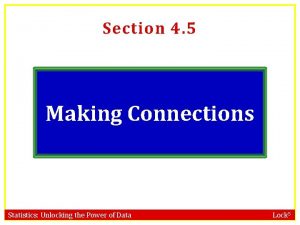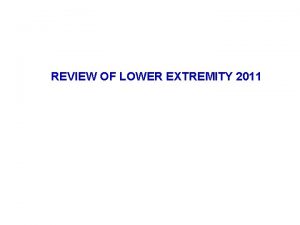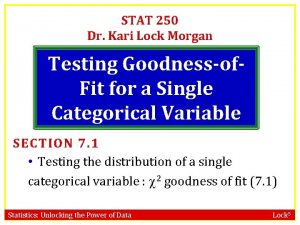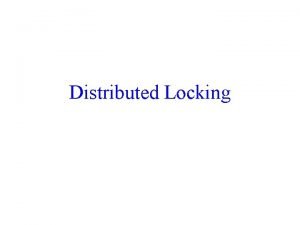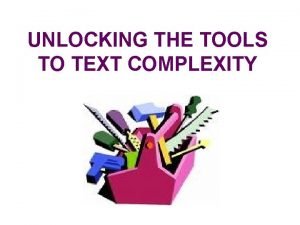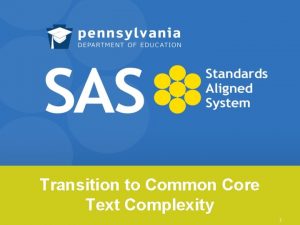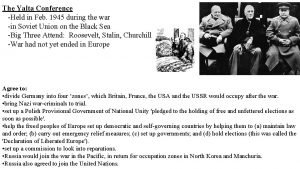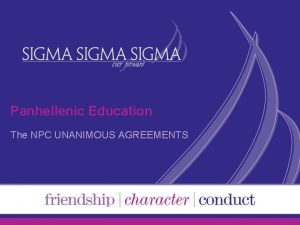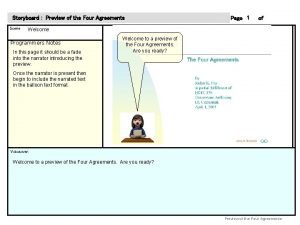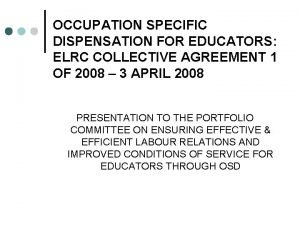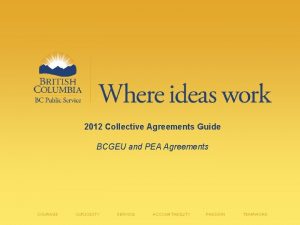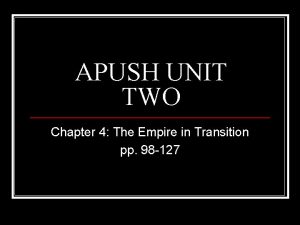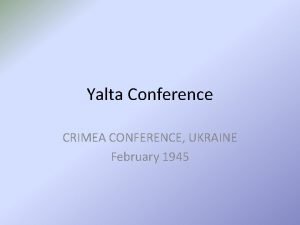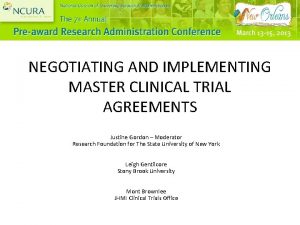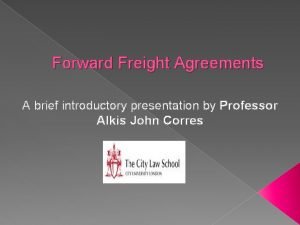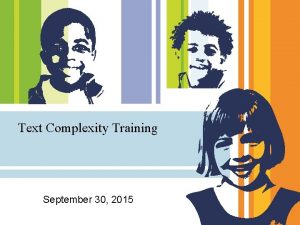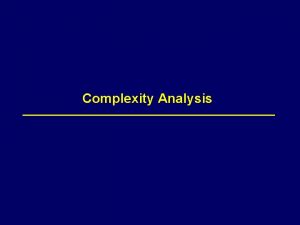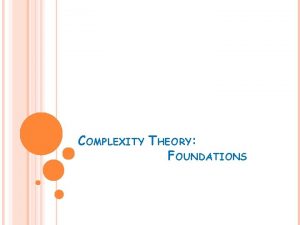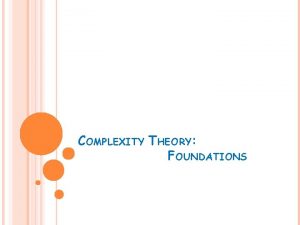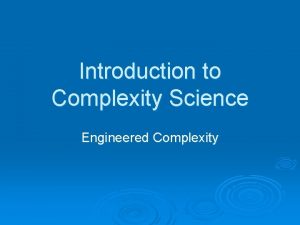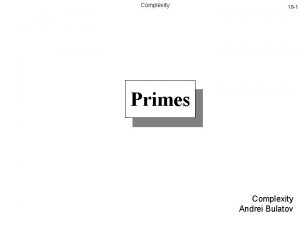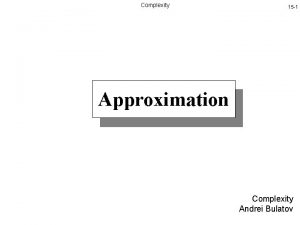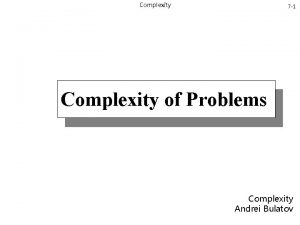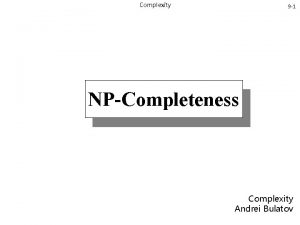UNLOCKING THE TOOLS TO TEXT COMPLEXITY Agreements We




























































- Slides: 60

UNLOCKING THE TOOLS TO TEXT COMPLEXITY


Agreements We will… – Assume Responsibility – Seek information – Participate actively – Integrate information – Respond act – Exchange ideas

Outcomes 1. 2. 3. 4. Understand reading standard #10. Understand the CCSS text complexity model. Practice using the quantitative measures tools. Practice using the qualitative rubrics for both literary and informational texts. 5. Analyze reader and task considerations and scaffolding possibilities for texts. 6. Practice generating a final recommendation form (i. e. , the “placemat”).

• • • • • • • • • • • Publishing Information ii Senate Bill 1200, Statutes of 2012, provided for an update of the California Common Core State Standards: English Language Arts and Literacy in History/ Social Studies, Science, and Technical Subjects (CA CCSS for ELA/Literacy). The CA CCSS for ELA/Literacy were modified on March 13, 2013, following the recommendation of State Superintendent of Public Instruction Tom Torlakson, to include the addition of the College and Career Readiness Anchor Standards and technical changes. When the CA CCSS for ELA/Literacy were modified, the members of the State Board of Education (SBE) were the following: Michael W. Kirst, President; Ilene Straus, Vice President; Sue Burr; Carl A. Cohn; Bruce Holaday; Josephine Kao; Aida Molina; Patricia Ann Rucker; Nicolasa Sandoval; and Trish Boyd Williams. Senate Bill 1 from the fifth Extraordinary Session (SB X 5 1) in 2010 established the California Academic Content Standards Commission (Commission) to evaluate the Common Core State Standards for English Language Arts and Literacy in History/Social Studies, Science, and Technical Subjects developed by the Common Core State Standards Initiative for rigor and alignment with the California standards. Based on the evaluation, the Commission inserted words, phrases, and select California standards to maintain California’s high expectations for students. On July 15, 2010, the Commission recommended that the SBE adopt the CA CCSS for ELA/Literacy as amended. The members of the Commission were the following: Greg Geeting, Chair; Heather Calahan; Steven Dunlap; Robert Ellis; Eleanor Evans; Bill Evers; Scott Farrand; Mark Freathy; Lori Freiermuth; Bruce Grip; Kathy Harris; Jeanne Jelnick; Deborah Keys; James Lanich; Matt Perry; Pat Sabo; Brian Shay; Alba Sweeney; Hilda Villarreal Writ; Chuck Weis; and Ze’ev Wurman. Support for the Commission was provided by the Sacramento County Office of Education under the direction of Sue Stickel, Deputy Superintendent of Schools. When the CA CCSS for ELA/Literacy were adopted by the SBE on August 2, 2010, the members of the SBE were the following: Theodore Mitchell, President; Ruth Bloom, Vice President; Alan Arkatov; James Aschwanden; Benjamin Austin; Yvonne Chan; Gregory Jones; David Lopez; and Johnathan Williams. Jack O’Connell, former State Superintendent of Public Instruction, is also recognized for his leadership during the adoption of the standards in August 2010. The California Common Core State Standards: English Language Arts and Literacy in History/Social Studies, Science, and Technical Subjects was edited in part by the staff of CDE Press, with the cover and interior design prepared by Tuyet Truong. It was published by the California Department of Education, 1430 N Street, Sacramento, CA 95814 -5901. It was distributed under the provisions of the Library Distribution Act and

Activity My Grandmother’s Hair As a small group, read “My Grandmother’s Hair” and answer the three questions provided at the bottom of the page…

Strategy: Stop and Share • On a scale of 1 to 10, how would you rate the overall complexity of this text? • What features of this text support your rating of its complexity? • At what grade level might this text be appropriate for instruction? Why? Answer in small group and share out to whole group

Text Complexity – Why Is This Important? Ø Complexity of texts students are expected to read is below what is required to achieve college and career readiness: – High school textbooks have declined in all subject areas over the last several decades – Average length of sentences in K-8 textbooks has declined from 20 to 14 words – Vocabulary demands have declined since the 1960 s: • 8 th grade textbooks = former 5 th grade texts • 12 th grade anthologies = former 7 th grade texts Ø Complexity of college and career texts has remained steady or increased, resulting in a gap

Text Complexity Gap

How Do We Address This Gap?

Video Overview of Text Complexity • https: //www. teachingchannel. org/videos/sim plifying-text-complexity

How Should Instruction Address Text Complexity? Read Aloud Read Along Read Alone Modeling of decoding and fluency Some scaffolding, as needed, for decoding, fluency, vocabulary, and comprehension Independent, autonomous reading Heavy scaffolding for vocabulary and comprehension Little to no scaffolding Gradual Release of Responsibility (I do, we do, you do)… Student Autonomy Teacher Scaffolding RA! RA! Reading!

Text Complexity “The Common Core Standards hinge on students encountering appropriately complex texts at each grade level in order to develop the mature language skills and the conceptual knowledge they need for success in school and life” (p. 3).

Areas of Emphasis for Instruction 1. Building knowledge through a balance of literary and informational texts. 2. Reading, writing, and discussion grounded in evidence from text, both literary and informational. 3. Regular practice (“productive struggle”) with complex text and its academic vocabulary.

Text Complexity Specifically, reading standard #10: Anchor Standard: R. CCR. 10 Read and comprehend complex literary and informational texts independently and proficiently. Example Grade-level Standard (6 th grade): RI. 6. 10 By the end of the year, read and comprehend literary nonfiction in the grades 6 -8 text complexity band proficiently, with scaffolding as needed at the high end of the range.

Strategy: Stop and Tweet The Common Core anchor standards address what a 21 st Century diploma holder should be able to do in order to flourish. • As a TL, what does this statement mean to you? • How does this statement affect our instruction and student learning?

Guiding Questions So… What do the Common Core State Standards mean by text complexity? What is a text complexity band? and How do we ensure the texts our students are reading are in the appropriate text complexity band? 17

How do we determine the grade-level complexity of a text? Quantitative Readability measures—Lexile Qualitative – Levels of Meaning – Language Conventionality & Clarity – Structure – Knowledge Demands Reader &Task Teacher judgment based on knowledge of students

CCSS Text Complexity Model

Where Do We Find Texts in the Appropriate Text Complexity Band? We could…. Use available resources to determine the text complexity of other materials on our own. Choose an excerpt of text from Appendix B: or…

Determining Text Complexity A Four-step Process: ve Qu alit ati 4. Recommend placement in the appropriate text complexity band. ive tat 3. Reflect upon the reader and task considerations. nti 2. Analyze the qualitative measures of the text. a Qu 1. Determine the quantitative measures of the text. Reader and Task

Step 1: Quantitative Measures such as: • Word length • Word frequency • Word difficulty • Sentence length • Text cohesion

Step 1: Quantitative Measures The Quantitative Measures Ranges for Text Complexity: This document outlines the suggested ranges for each of the text complexity bands using: • Lexile Text Measures

Step 1: Quantitative Measures Resources for Accessing Quantitative Measures of Text Which may include: • Lexile • ATOS book level • Additional measures • Readability formulas

Step 1: Quantitative Measures Let’s imagine we want to see where a text falls on the quantitative measures “leg” of the text complexity triangle, using either the Lexile text measure or the ATOS book level (or both). For illustrative purposes, let’s choose Harper Lee’s 1960 novel To Kill a Mockingbird.

Step 1: Quantitative Measures Finding a Lexile Measure for Text: http: //www. lexile. com/findabook/ 26

Step 1: Quantitative Measures 27

Step 1: Quantitative Measures 28

Step 1: Quantitative Measures For texts not in the Lexile database, consider using the Lexile Analyzer: http: //www. lexile. com/analyzer/ • Registration is required (free) http: //www. lexile. com/account/register/ • Allows user to receive an “estimated” Lexile score • Accommodates texts up to 1000 words in length • Texts of any length can be evaluated using the Professional Lexile Analyzer—educators can upgrade to this tool for free by requesting access http: //www. lexile. com/account/profile/access/

Step 1: Quantitative Measures Lexile Text Measure: 870 L In which of the text complexity bands would this novel fall?


Step 1: Quantitative Measures Remember, however, that the quantitative measures is only the first of three “legs” of the text complexity triangle. Our final recommendation may be validated, influenced, or even over-ruled by our examination of qualitative measures and the reader and task considerations. 32

Step 1: Quantitative Measures Activity: Your Turn! Using Lexile. com as a tool: • Identify a quantitative measure for one of the texts your teachers use with students. • Identify the text complexity band in which this text would be placed based only upon the quantitative measure. Discuss your results as a small group.

Step 2: Qualitative Measures such as: • Levels of meaning • Levels of purpose • Structure • Organization • Language conventionality • Language clarity • Prior knowledge demands

Step 2: Qualitative Measures The Qualitative Measures Rubrics for Literary and Informational Text: The rubric for literary text and the rubric for informational text allow educators to evaluate the important elements of text that are often missed by computer software that tends to focus on more easily measured factors.

Step 2: Qualitative Measures Because the factors for literary texts are different from information texts, these two rubrics contain different content. However, the formatting of each document is exactly the same. And because these factors represent continua rather than discrete stages or levels, numeric values are not associated with these rubrics. Instead, four points along each continuum are identified: high, middle high, middle low, and low.

Step 2: Qualitative Measures Questions to Consider in Planning for Instructional Scaffolding On the back side of each rubric is list of springboard questions to help educators begin thinking about the kinds of instructional scaffolding the text may also require.

Step 2: Qualitative Measures So… How is the rubric used? And how would To Kill a Mockingbird fare when analyzed through the lens of the Literary Text Rubric?

39

Step 2: Qualitative Measures From examining the quantitative measures, we knew: Lexile Text Measure: 870 L But after reflecting upon the qualitative measures, we believed:

Step 2: Qualitative Measures tat ali Qu e tiv tita an The reader and task considerations still remain. Qu Remember, however, that we have completed only the first two legs of the text complexity triangle. ive Our initial placement of To Kill a Mockingbird into a text complexity band changed when we examined the qualitative measures. Reader and Task

Step 2: Qualitative Measures Discuss: Your Turn! Using the rubrics for literary text, analyze the qualitative measures of the following titles: • “My Grandmother’s Hair” (literary text)— 1130 L Discuss your results as a small group.

Step 3: Reader and Task Considerations such as: • Motivation • Knowledge and experience • Purpose for reading • Complexity of task assigned regarding text • Complexity of questions asked regarding text

Step 3: Reader and Task Considerations Questions for Professional Reflection on Reader and Task Considerations: The questions provided in this resource are meant to spur teacher thought and reflection upon the text, students, and any tasks associated with the text.

Step 3: Reader and Task Considerations The questions included here are largely open-ended questions without single, correct answers, but help educators to think through the implications of using a particular text in the classroom.

Step 3: Reader and Task Considerations What aspects of the text will likely pose the most challenge for my students? • Content or theme concerns or challenges? • Text structure challenges? • Language feature challenges? • Knowledge and experience demands? • Motivation for and interest in the text?

Step 3: Reader and Task Considerations What supports do I need to provide so that all of my students (even those who are struggling readers) can access the text?

How Should Instruction Address Text Complexity? Read Aloud Read Along Read Alone Modeling of decoding and fluency Some scaffolding, as needed, for decoding, fluency, vocabulary, and comprehension Independent, autonomous reading Heavy scaffolding for vocabulary and comprehension Little to no scaffolding Gradual Release of Responsibility (I do, we do, you do)… Student Autonomy Teacher Scaffolding RA! RA! Reading!

RA, RA Reading! In Action

Step 3: Reader and Task Considerations Based upon our examination of the Reader and Task Considerations, we have completed the third leg of the text complexity model and are now ready to recommend a final placement within a text complexity band.

Step 4: Recommended Placement After reflecting upon all three legs of the text complexity model we can make a final recommendation of placement within a text and begin to document our thinking for future reference.

Step 4: Recommended Placement Lexile Text Measure: 870 L

Step 4: Recommended Placement Based upon all the information—all three legs of the model—the final recommendation for To Kill a Mockingbird…


Step 4: Recommended Placement In this instance, Appendix B confirms our evaluation of the novel. To Kill a Mockingbird is placed within the grade 9 -10 text complexity band.

Step 4: Recommended Placement Template for Text Complexity Analysis and Recommended Placement Form: The one-page template provides an opportunity to record the thinking involved in recommending the placement of a specific text into a text complexity band. Keeping a record of such analysis and thinking might be useful documentation in the case that any questions arise in the future.


Group Activity: 10 minutes Read the poem, “Introduction to Poetry” Using the Text Complexity tools discussed, determine the following: • Quantitative • Qualitative • Reader and Task Share findings with your table group!

Step 4: Recommended Placement Think about… How can I apply this model in the work that I do as a TL and encourage others I work with to embrace the model as well?

Final Activity
 Time space complexity of algorithm
Time space complexity of algorithm Making connections images
Making connections images Unlocking the secrets of mohenjodaro
Unlocking the secrets of mohenjodaro Unlocking the secrets of mohenjodaro
Unlocking the secrets of mohenjodaro Statistics unlocking the power of data answer key
Statistics unlocking the power of data answer key Unlocking behaviour change
Unlocking behaviour change Unlocking the secrets of mohenjodaro
Unlocking the secrets of mohenjodaro Statistics: unlocking the power of data pdf
Statistics: unlocking the power of data pdf Unlocking the secrets of the sun
Unlocking the secrets of the sun Bursitis knee pictures
Bursitis knee pictures Intracapsular but extrasynovial
Intracapsular but extrasynovial Lateral rotation of thigh muscles
Lateral rotation of thigh muscles Keys to god's blessings
Keys to god's blessings Statistics: unlocking the power of data 1st edition
Statistics: unlocking the power of data 1st edition Art genus
Art genus Locking and unlocking of knee joint
Locking and unlocking of knee joint Unlocking possibilities
Unlocking possibilities Coaching is unlocking a person's potential
Coaching is unlocking a person's potential Text complexity rubric
Text complexity rubric Text complexity qualitative measures rubric
Text complexity qualitative measures rubric Expanding the pie negotiation
Expanding the pie negotiation Yalta conference agreements
Yalta conference agreements Unanimous agreements
Unanimous agreements International hardwood agreements
International hardwood agreements Supplier rebate agreements
Supplier rebate agreements Agreement meaning of which is uncertain
Agreement meaning of which is uncertain The four agreements preview
The four agreements preview Mpi salary bands
Mpi salary bands Ltsa long term service agreement
Ltsa long term service agreement Bcgeu collective agreements
Bcgeu collective agreements Lrb collective agreements
Lrb collective agreements What is a defective agreement
What is a defective agreement Nonimportation agreements apush
Nonimportation agreements apush Yalta conference agreements
Yalta conference agreements Master clinical trial agreement
Master clinical trial agreement Horizontal agreements examples
Horizontal agreements examples Forward freight agreement example
Forward freight agreement example International framework agreements
International framework agreements Forward rate agreements
Forward rate agreements Drafting license agreements
Drafting license agreements Supplier rebate agreement
Supplier rebate agreement Cutting tools in sewing with pictures and meaning
Cutting tools in sewing with pictures and meaning Hát kết hợp bộ gõ cơ thể
Hát kết hợp bộ gõ cơ thể Frameset trong html5
Frameset trong html5 Bổ thể
Bổ thể Tỉ lệ cơ thể trẻ em
Tỉ lệ cơ thể trẻ em Voi kéo gỗ như thế nào
Voi kéo gỗ như thế nào Tư thế worm breton
Tư thế worm breton Chúa yêu trần thế alleluia
Chúa yêu trần thế alleluia Các môn thể thao bắt đầu bằng tiếng đua
Các môn thể thao bắt đầu bằng tiếng đua Thế nào là hệ số cao nhất
Thế nào là hệ số cao nhất Các châu lục và đại dương trên thế giới
Các châu lục và đại dương trên thế giới Công của trọng lực
Công của trọng lực Trời xanh đây là của chúng ta thể thơ
Trời xanh đây là của chúng ta thể thơ Mật thư tọa độ 5x5
Mật thư tọa độ 5x5 Làm thế nào để 102-1=99
Làm thế nào để 102-1=99 độ dài liên kết
độ dài liên kết Các châu lục và đại dương trên thế giới
Các châu lục và đại dương trên thế giới Thể thơ truyền thống
Thể thơ truyền thống Quá trình desamine hóa có thể tạo ra
Quá trình desamine hóa có thể tạo ra Một số thể thơ truyền thống
Một số thể thơ truyền thống


